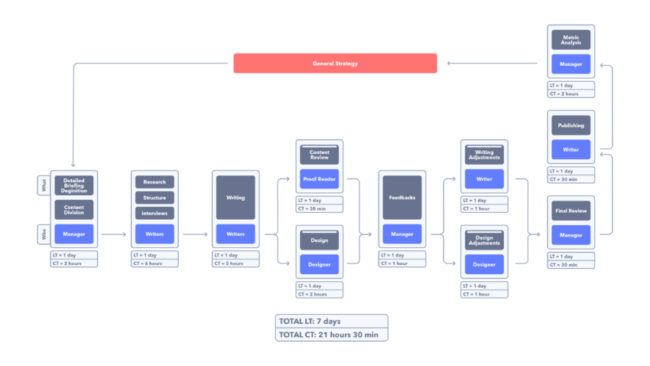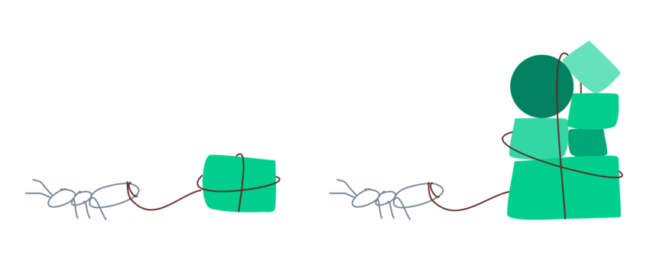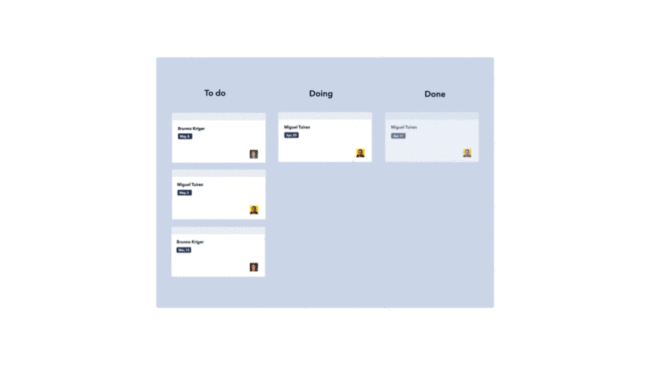ARTICLE SUMMARY
Improve your management skills with lean marketing practices and learn how to optimize your processes and better coordinate your team's activities.

Working in Digital Marketing can be challenging. The market moves fast, your routine is busy and you must reinvent yourself every day to keep up with hypes and strategies. So how can you deliver more and add outrageous value to your company?
This content will help you better manage your department and improve your strategies. You’ll learn how to successfully apply Lean to marketing, optimize your to-do list and better coordinate your activities and your team.
First Things First: What is Lean?
It is safe to say that the culture of improvement, resources optimization, delivery of results and the search for better strategies is intrinsic in any marketer’s soul. And Lean has everything to do with this.
But what is Lean? This methodology—that can be better defined as a philosophy—was developed by Engineer Taiichi Ohno (Toyota) based on the idea of “changing for the better.” The goal is to continuously improve the way companies work, eliminating waste and creating customer value. It can be easily applied to different markets and departments of firms.
Even though Lean comes from the industry, companies such as Amazon, Pixar and FedEx became huge case studies. The reason behind it is simple: it can be applied to basically everything in life. And soon you’ll understand why.
More Value, Less Waste and Infinite Improvement
Value
One of the most important foundations of Lean thinking is that everything you do must add value to the stakeholders. In the case of a marketing department, delivering value is generating more results with fewer resources.
In order to do that successfully, ask yourself: Is my approach aligned with the company’s goals? Is your team being truly productive? Are your resources being wisely spent? To find that out, the first step is to Value Stream Map (VSM) your marketing!
How Does a Value Stream Map Work?
A Value Stream Map (VSM) is a dynamic and visual tool that allows you to understand all the steps of an operation. It’s used to document, illustrate, analyze and improve processes. It can be applied to your strategy on a regular basis to keep track of all the department activities.
Why? VSM will help you visualize the overall process, providing a holistic view of the way things actually work, mostly and mainly because you build it while experiencing the process in question.
It’s a great tool for you to provide a blueprint for improvement implementation, apart from an excuse to gather your team and get everyone involved. Here’s an example of a Marketing VSM:

Five Steps to Build Your Marketing VSM
- List everything your team needs to VSM and rank according to resource optimization levels. The higher the level of optimization, the higher its priority;
- Agree with your team on which symbols better represent what you want to analyze (as represented in the Marketing VSM image). Pro tip: make a symbol board so you won’t forget all the meanings;
- Go to the place where the work gets done—which in Lean is called the Gemba—to map and draw the flow of the process on a big piece of paper. Pro tip: use post-it and pencil, so you can adjust as much as necessary;
- Gather the team and map these three pieces of information:
a. Who are the people involved in each step of the process;
b. What are the activities that compose each step;
c. The time frame of each step: how much time each part of the process takes until it’s finished, such as production time, waiting for approval, corrections and actual delivery; - Analyze it! Look at your metrics—people, activities and timing—and try to find your bottlenecks. Understand their origins, how you can change them and which actions will improve your time and eliminate waste. Pro tip: Don’t be shy and involve everyone on the team!
Bottleneck: a piece of equipment, a person, a department or anything that blocks a process and keeps it from running smoothly
Now that you know how to map where your value comes from, it’s important to keep in mind that all the campaigns, contents and assets your team creates should be adding value to your client—the company.
Waste
Waste in Lean is everything that doesn’t add value to the customer.
Unfortunately, marketers experience waste daily. Actually, spoiler alert—if you’re reading this content because you need some improvements in your marketing operations, it’s probably because of waste! That’s why I’m going to show you some examples and teach you how to eliminate them using Lean tools.
Some common examples of waste in marketing are:
- Using strategies or tools that aren’t actually adding value to the company, such as being on a social media that doesn’t make sense at the moment, or flooding your leads with emails knowing that they aren’t interested at all.
- Creating entire campaigns, content and even strategies that are never put into action.
- Doing manual work that could be done automatically.
- Holding unnecessary meetings or meetings without agendas.
- A simple approval going through too many people.
- Waiting more time than necessary for an approval.
- Overburdening part or the whole team.
- All kinds of rework.
- The list goes on…
Can you relate to any of that? I know. These situations happen all the time. So how in the world can waste in marketing be prevented?
That’s right! LEAN!
First, you need to understand your wastes, so you’ll be able to prevent them from being generated and to act quickly when they occur. In order to do so, the best Lean marketing departments adopt two practices: creating flow and eliminating the 3Ms. This is how they do that:
Create Flow
Flow is the state of a process in which the parts move from one step to another as smoothly as possible, without compromising quality. In order to make this a reality, recognizing and eliminating obstacles is a must. That’s what we’re aiming for. This is Lean!
How we identify and get rid of them leads us to the next point: The 3Ms of Lean.
Mura, Muri and Muda
The 3Ms of Lean are for the Japanese words Mura, Muri and Muda. Don’t worry, you don’t need to know all of these Japanese words by heart, but it’s in Lean’s roots, so it’s important to be aware of them.
Here are some practical examples of “M” in marketing.
Mura – Unevenness, variation, irregularity
- Any activity, task, process or person that is not steady
- If the workflow is uneven, there are times that your team works too much, and times they work too little
- When there’s someone on your team that has a completely different workflow than the others
- When you can’t check and release approvals in a timely fashion because they irregularly bog you down at once

Muri – Overburden
- Any activity, task, process or person that is overburdened
- When someone in your team has a huge amount of work while the rest of the team is otiose
- When you focus your strategy only on one channel, even if it’s not giving you the results it used to
- When you need to print material for your next event, but you do it all at once, right before your deadline

Muda – Uselessness, wastefulness, futility
- Any activity, task, process or person that is useless
- When you use a tool because it’s the new hype, but it actually doesn’t bring any kind of value to the company
- When you need to make something all over again because what was done before doesn’t make sense anymore (because it hasn’t been actually thought through)
- When you make complex sheets to measure your metrics manually

Now that you have an idea of the types of waste you face daily and understand that waste comes in different forms and shapes, you can actually prevent them, stop them earlier and cease them as soon as possible.
Once the existing waste is gone, the ideal scenario is to build a pull system, so you and your team won’t have to deal with waste—especially Muda—any longer.
Lean Pull System
Pull systems are about getting work done if and when there’s an actual demand for it. When you’re not producing something just in case it’s needed someday, you reduce waste.
Imagine that you work in the marketing department of a furniture store and the social media in your team predicts Instagram posts for the whole month. They get everything ready: pictures, captions and even some story options. The first week everything goes as planned, but then, in the following week, design launches a new collection. Next, there’s an event to celebrate this accomplishment with invited architects. Then, a sales promotion is planned in order to sell out old collections. By the end of the month, part of the content previously planned is stored. The social media wanted to buy time by predicting content, but they ended up wasting it by acting before the actual demand was created.
That’s why having a pull system is so important. You won’t lose time planning and putting something into action if it’s not going to add value. You’ll only act when an actual demand exists it. This is Lean.
Yes, it can be as obvious, but sometimes things can get out of control and some waste may pass by unnoticed. In order to prevent that, there’s another powerful tool you can—and should—use in your routine. Meet Kanban.
Kanban
Kanban is a tool that helps you better organize your activities, stock and delegations through phases and visual signs, such as cards (physical or digital), containers or any device that communicates instructions. Whether your marketing is well organized or a bit messy, you can definitely benefit from this tool!

Build a Kanban in Five steps
The easiest way to build a Kanban is to use post-its in a wall, on a large piece of paper or even by using a digital Kanban platform—such as Pipefy.
- Divide your activities into different columns according to your process and its phases. For example: To Do; Priority; Doing; Delayed; Under Approval; Corrections; Approved; Released;
- Define a color code, so you can visualize who is responsible for each activity. For example, Jane is blue; John is orange, Lucy is yellow and Alex is pink;
- Start writing the activities down in post-its according to the color code. Each post-it represents a different activity. Some interesting pieces of information that you should include are:
a. The activity in question;
b. The deadline (remember to write it in a way so you can easily spot it—try to use a different pen, for example);
c. If there’s someone else helping with the activity;
d. Other relevant details. - Now it’s time to assign the post-its to the designated columns;
- Congratulations, you just build your first Kanban!
Now all you have to do is to pay attention to the board and encourage everyone to keep track of their activities and move their post-its to the other columns according to the development of their responsibilities.
Pro tip: If you want to be even Leaner, try using a digital Kanban.
This method is as Lean as it can possibly be, so don’t be afraid of using it every day in order to avoid any kind of waste, and keep improving your game!
Continuous Improvement
Now that you’ve learned about Value and Waste, you’re ready to understand the importance of Continuous Improvement—Lean’s third foundation. Only when you apply all of them together, your marketing will truly become Lean.
In Lean, Continuous Improvement is also known as Kaizen. More than a practice, it’s an entire culture that believes in improving not only processes but also the lives of people. It means that even if you already add value and eliminate waste, there will always be space for improvements.
When talking about improvements in marketing, it means:
- Keeping up with your KPIs
You probably don’t want to drop the ball, right? Keeping an eye on your Key Performance Indicators and refreshing them regularly is essential to retain your authority and reputation, and also for keeping your team engaged and productive. - Improving and renewing your strategies every now and then
The same thing happens here. You need to understand the market hypes and how to align them with your company’s target and goals. Maybe it works now, but will it work as well tomorrow? - Making tests of everything you can
Marketing is all about tests. Sometimes an adjustment of color in a landing page, or even the tone of the content in your blog posts is what’s keeping you from achieving greater success. - Engaging your team to bring new ideas every day
Brainstormings are great, but have you tried supporting your team on bringing forth new ideas and empowering them to own these ideas? It will keep everyone productive and highly involved, always looking out for the company’s best interest.
Go Lean or Go Home
Now you know that adding value, eliminating waste and continuously improving are the keys to conquer Lean marketing. Keeping these three foundations in mind will help you have a Lean and happy marketing team sooner than you know!
Remember: When applying Lean, always seek ways to inspire everyone to constantly be the best version of themselves. To be the Leaner version of themselves.
Are you ready to become Lean? Go Lean or go home!





